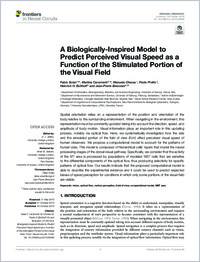A biologically-inspired model to predict perceived visual speed as a function of the stimulated portion of the visual field
- Solari, Fabio Department of Informatics, Bioengineering, Robotics, and Systems Engineering, University of Genova, Genoa, Italy
- Caramenti, Martina Department of Neuroscience and Movement Science, University of Fribourg, Fribourg, Switzerland - Istituto di Bioimmagini e Fisiologia Molecolare, Consiglio Nazionale delle Ricerche, Segrate, Italy
- Chessa, Manuela Department of Informatics, Bioengineering, Robotics, and Systems Engineering, University of Genova, Genoa, Italy
- Pretto, Paolo Virtual Vehicle Research Center, Graz, Austria
- Bülthoff, Heinrich H. Department of Cognitive and Computational Psychophysics, Max Planck Institute for Biological Cybernetics, Tubingen, Germany
- Bresciani, Jean-Pierre Department of Neuroscience and Movement Science, University of Fribourg, Fribourg, Switzerland - University Grenoble Alpes, LPNC, Grenoble, France
- 30.10.2019
Published in:
- Frontiers in Neural Circuits. - 2019, vol. 13, p. 68
English
Spatial orientation relies on a representation of the position and orientation of the body relative to the surrounding environment. When navigating in the environment, this representation must be constantly updated taking into account the direction, speed, and amplitude of body motion. Visual information plays an important role in this updating process, notably via optical flow. Here, we systematically investigated how the size and the simulated portion of the field of view (FoV) affect perceived visual speed of human observers. We propose a computational model to account for the patterns of human data. This model is composed of hierarchical cells' layers that model the neural processing stages of the dorsal visual pathway. Specifically, we consider that the activity of the MT area is processed by populations of modeled MST cells that are sensitive to the differential components of the optical flow, thus producing selectivity for specific patterns of optical flow. Our results indicate that the proposed computational model is able to describe the experimental evidence and it could be used to predict expected biases of speed perception for conditions in which only some portions of the visual field are visible.
- Faculty
- Faculté des sciences et de médecine
- Department
- Département de Médecine
- Language
-
- English
- Classification
- Biological sciences
- License
- License undefined
- Identifiers
-
- RERO DOC 327723
- DOI 10.3389/fncir.2019.00068
- Persistent URL
- https://folia.unifr.ch/unifr/documents/308369
Statistics
Document views: 65
File downloads:
- bre_bim.pdf: 140
